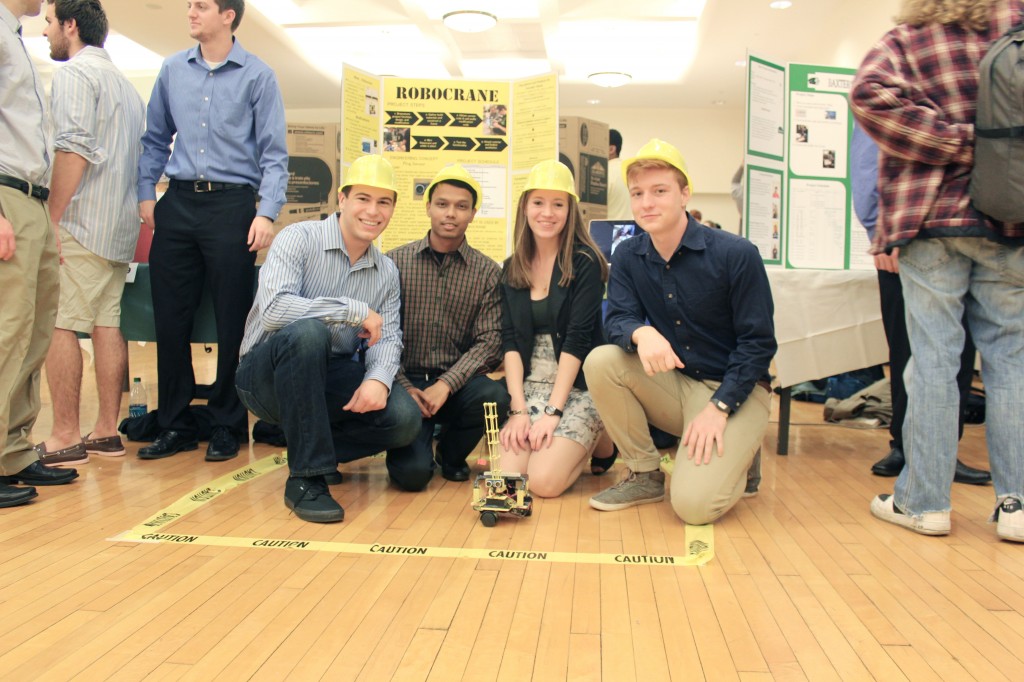
The Mandela Room was transformed on Monday into an exhibition full of flashing lights, techno music and flying robots.
Binghamton University’s Engineering Design Division, a program at BU designed to help engineering students transition from high school to college with two hands-on projects, hosted its fifth annual Arduino Expo. The Expo showcased interactive projects built by 74 teams of three to five freshman Watson School students.
Contestants were required to build any interactive object using the Arduino board, a micro-controller board that can be programmed to interact with its surroundings. The projects could be creative and incorporate other engineering products and software, like LED lights and screens, motion-sensors and circuits.
Professor Sharon Fellows, who organized the Expo, said the exhibition allowed students to strengthen their presentation and team-building project documentation skills. The projects ranged from reflective disco balls and guitar tuners to motion-censored robots and colorful LED lamps.
Anna Chan, a freshman majoring in industrial and systems engineering, and her team created a fortune-teller that generated a fortune on an analog screen when fed a quarter.
“Our project is attached to an LCD screen, four LEDs, a pushbutton and two wires,” Chan said. “When you insert a coin, it closes the circuit and gives you a fortune.”
One team displayed a miniature pirate’s treasure chest adorned with gold coins and pirate figurines that played melodies whenever opened. The music box incorporated a tilt switch, a component to the Arduino board that acted as a vibration sensor. The boards were also coupled with computer software and one team was able to alter the coding to generate a random light show and play a different tune whenever the chest was reset.
“If you clap, the vibration will send a ball back inside the tilt switch,” said Natalie Zanco, a freshman majoring in engineering, about her team’s project. “The tilt switch is what resets everything when you close and open the box. With this, you’re allowed to reset the music and light display without actually closing the box.”
Michael Spano, a sophomore majoring in mechanical engineering, said his favorite project featured lights that were activated whenever a Nerf gun was shot in the board’s general direction. He also said he liked the Object-Avoidance robot called ATLAS, a balloon robot that floated away from any approaching objects obstructing its path.
Another project consisted of an enhanced version of a BU Bike Share bicycle.
“What we wanted to do was to bring the bike into the 21st century,” said Cody Fizette, a member of the design team and a freshman majoring in bioengineering said. “Why shouldn’t it have the same features that cars have?”
The team used the Arduino board to build a speedometer, resembling one found on a typical car.
“We put directional signals on the back so it makes turn signals much easier,” Fizette said. “Instead of using hand signals, you flip a switch and tell people where you are going.”
All students participating in the event learned how to work in groups and manage their time to successfully create functioning interactive objects, according to Fellows.
But Zanco said that the process of creating the final project had its challenges.
“We each had our ups and downs when working on the teams,” Zanco said. “There were times when things didn’t go as planned.”
Despite these hardships, all teams were able to successfully construct a project using the Arduino. Thomas Brinskelle, a freshman majoring in mechanical engineering, said his team created an “avoidance robot,” which uses an electronic sensor to navigate its path. He said the project and experience were difficult but rewarding.
“It avoids any obstacles autonomously,” Brinskelle said. “Most of them happen to be on the ground and use wheels; ours happens to be floating. We really wanted to make something unique. We wanted to challenge ourselves.”


